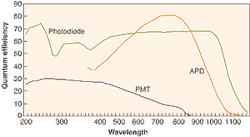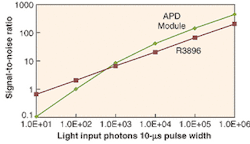The choice between a photodiode, an avalanche photodiode, and a photomultiplier tube depends on whether gain is required and how much noise can be tolerated.
In the past decade, many of the techniques developed by analytical chemists have migrated to the field of biotechnology. High-performance liquid chromatography, ultraviolet-visible absorption instruments, and mass spectrometers are now designed to meet the needs of chemists conducting drug discovery and genetic analysis. Many of these instruments use photodetectors such as photodiodes, avalanche photodiodes (APDs), and photomultipliers (PMTs) for identification or quantification. Selecting the proper detector is contingent upon understanding their performance in the applications in which they will be used.
When considering a detector, the first and most critical step is to define the specifications of the application. Factors such as light power, frequency bandwidth, wavelength, power consumption, and cost will dictate what detector technology must be used (see Fig. 1). Once a detector is chosen, the following criteria can be used to aid in a final selection.
Photodiodes and APDs
The silicon photodiode commonly operates in the photovoltaic mode, in which no bias voltage is applied. It is also possible to apply a reverse bias to the photodetector. Known as the photoconductive mode, this has the effect of increasing the electric-field strength between the electrodes and the depth of the depletion region. The advantages of the photoconductive mode are higher speed, lower capacitance, and better linearity. One drawback, however, is that the dark current becomes larger with increasing bias voltage because the dark current is dependent on the reverse bias voltage. Generally, PIN photodiodes and APDs operate in this fashion. Photodiodes offer high quantum efficiency, high stability, and simplicity. The biggest disadvantage is the lack of internal gain.
The APD is a specialized silicon PIN photodiode designed to operate with high reverse bias voltages (see Fig. 2). Large reverse voltages generate high electric fields at the p-n junction. Some of the electron-hole pairs passing through or generated in this field gain sufficient energy (greater than the bandgap energy) to create additional electron-hole pairs. This process is known as impact ionization. If the newly created electron-hole pairs acquire enough energy, they also create electron-hole pairs. This avalanche multiplication is the mechanism by which APDs produce internal gain. Internal gain is an important attribute when the detector is combined with an amplifier. Avalanche photodiodes have the advantage of the same high quantum efficiency (30% to 90%) as a photodiode but with the addition of an internal gain of 30 to 200; however, they suffer from noise (excess noise factor of 2 to 5, arising from amplification) and temperature instability. They are well suited to applications requiring high-speed signal detection of weak optical signals in the red and near-infrared.The photomultiplier tube
The PMT is a vacuum-tube device in which the optical photon is converted into an electron by the photoelectric effect. One advantage of the PMT is that the photoelectric surface (photocathode) can be very large—in excess of 5000 cm2. This size can be very important when the light source is diffuse. The photoelectron is then amplified in a cascade of dynodes that is capable of generating a gain in excess of 1 × 106. As an added benefit, the gain is virtually noise free (excess noise factor of 1.2 to 1.6).
The spectral response of the PMT can be adjusted by selection of the photocathode and falls within the 100- to 1700-nm range. Photocathodes have a typical quantum efficiency of 10% to 20%, although some newer semiconductor photocathodes have quantum efficiencies in excess of 40%. Photomultiplier tubes are required for measurements that must be made in a short time period or at high frequency, for weak optical signals where external amplifier noise is high, or where a very wide dynamic range of 105 is required. They can operate at light levels as low as a few photons per second to about a billion photons per second.
Performance
The performance of a detector in any application is fundamentally limited by the noise in the light signal itself. Because of the quantum nature of light, Poisson statistics determine the variation in any measurement of photons; the theoretical maximum signal-to-noise (S/N) ratio is simply the square root of the number of detected photons. If one needs a S/N ratio of 100, at least 10,000 photons must be detected.
Quantum efficiency is simply the ratio of incident photons to detected photons. For example, if 100 photons were incident on a detector and 10 were detected, the quantum efficiency would be 10%. Poisson statistics indicate that the detector with the highest quantum efficiency will perform best in any application.
In a perfect world, quantum efficiency would be enough of a determining factor; however, amplifier noise can and will bedevil detector performance. The best amplifiers have noise levels of a few hundred electrons root-mean-square (rms), while most are in the thousands or tens of thousands of electrons rms. When the amplifier noise becomes about half of the signal noise, a degradation in the S/N ratio will result. If the degradation becomes unacceptable, a detector with gain must be used.
The fundamental S/N ratio is determined by the number of photons and the quantum efficiency of the detector. The only function of gain is to amplify the fundamental S/N ratio above any noise influence from the amplifier circuit. For example, in a situation with a low photon count of 1000 and a high gain of 1 x 106, the gain completely eliminates the influence of the amplifier noise and the instrument becomes detector-noise limited, which is the designer's goal.
The multiplication process in detectors introduces an excess noise factor. Depending on the design and structure of the detector, the excess noise factor can be very low, as in a PMT, or large, as in an APD. Using a detector with gain when gain is not required will cause degradation in the S/N ratio. Such considerations help the designer to choose the right detector for a particular task (see Fig. 3).Applications
In absorption spectroscopy and high-performance liquid chromatography, for example, a discreet set of energy levels is associated with each species of atom, ion, and molecule. If light is passed through a gas or liquid sample with a wavelength identical to the energy level of material present in the sample, it will absorb the light. The amount of absorption is related to the amount of material present.
Most instruments using this technique will pass as much light as possible (at a particular wavelength) through a sample and look for a small change in the signal due to absorption. The detector would be required to observe a very small change in a signal so large that the amplifier noise is not relevant. Gain in the detector is not necessary; however, the S/N ratio must be as large as possible to detect the very small changes. In this case, a photodiode or photodiode array is the right choice. The high quantum efficiency provides the best possible S/N ratio.
In flow cytometry, a fluorescent probe consisting of an antibody with a fluorescent tag is used to mark a cell. These antibodies then bind to receptors on a target cell. Cells are passed in single file past a laser beam. The laser excites the fluorescence, which is then read by a photodetector. Traditionally, the role of the photodetector has been played well by a PMT; however, there is now a desire to use dyes in the red and infrared. The signal produced is a 1-μs pulse consisting of about 100,000 photons. Amplifier noise makes this signal too small for a photodiode. The gain of a PMT is well suited to this light level for visible-wavelength probes, but for long-wavelength probes the quantum efficiency of the PMT is marginal. The APD has high quantum efficiency and enough gain to offer good performance, making it the choice for this application.
In chemiluminecence detection, a chemical reaction produces a diffuse optical signal with an emission beginning about 700 nm and continuing to a few microns. The emission wavelength would indicate the use of an APD or photodiode. In fact, photodiodes are commonly found in this application. The diffuse nature of the emission requires as large a detector area as possible. Furthermore, the extremely low light level involved at low chemical concentrations (less than 100 ppb) requires the very high gain of a PMT. The amount of signal generated in a photodiode or APD would not be large enough to overcome amplifier noise.
Earl Hergert | VP of Marketing, Hamamatsu
Earl Hergert is VP of Marketing at Hamamatsu (Bridgewater, NJ).


